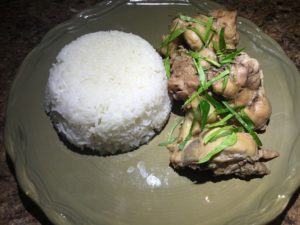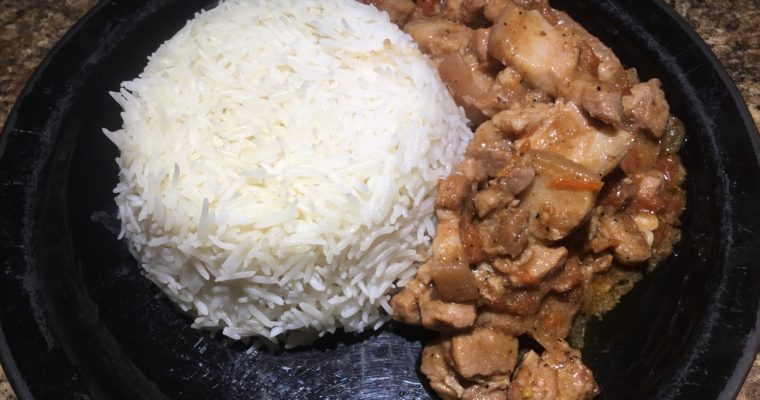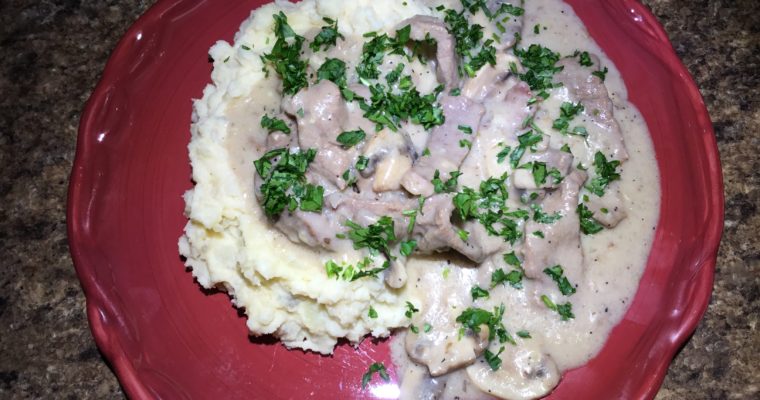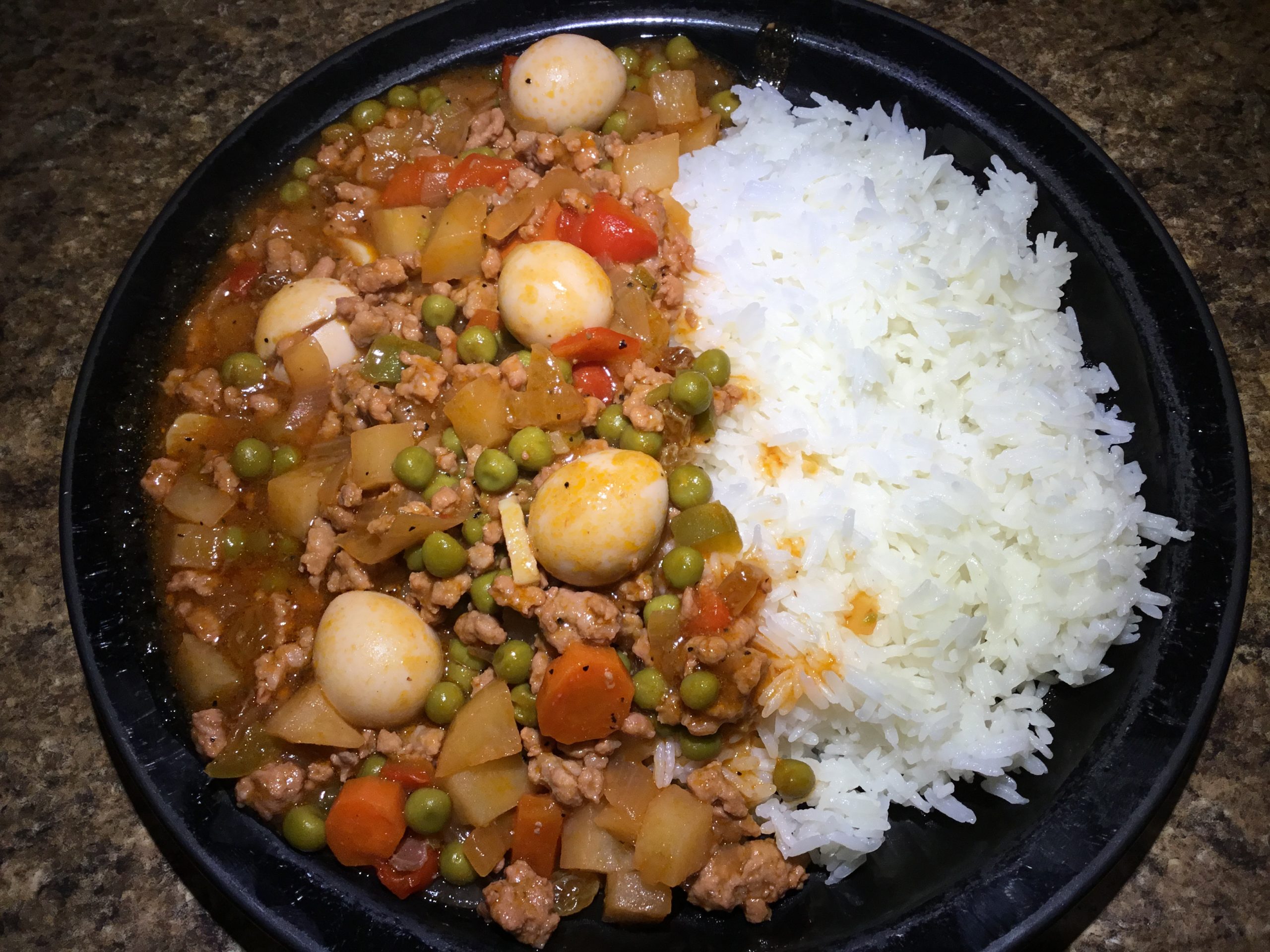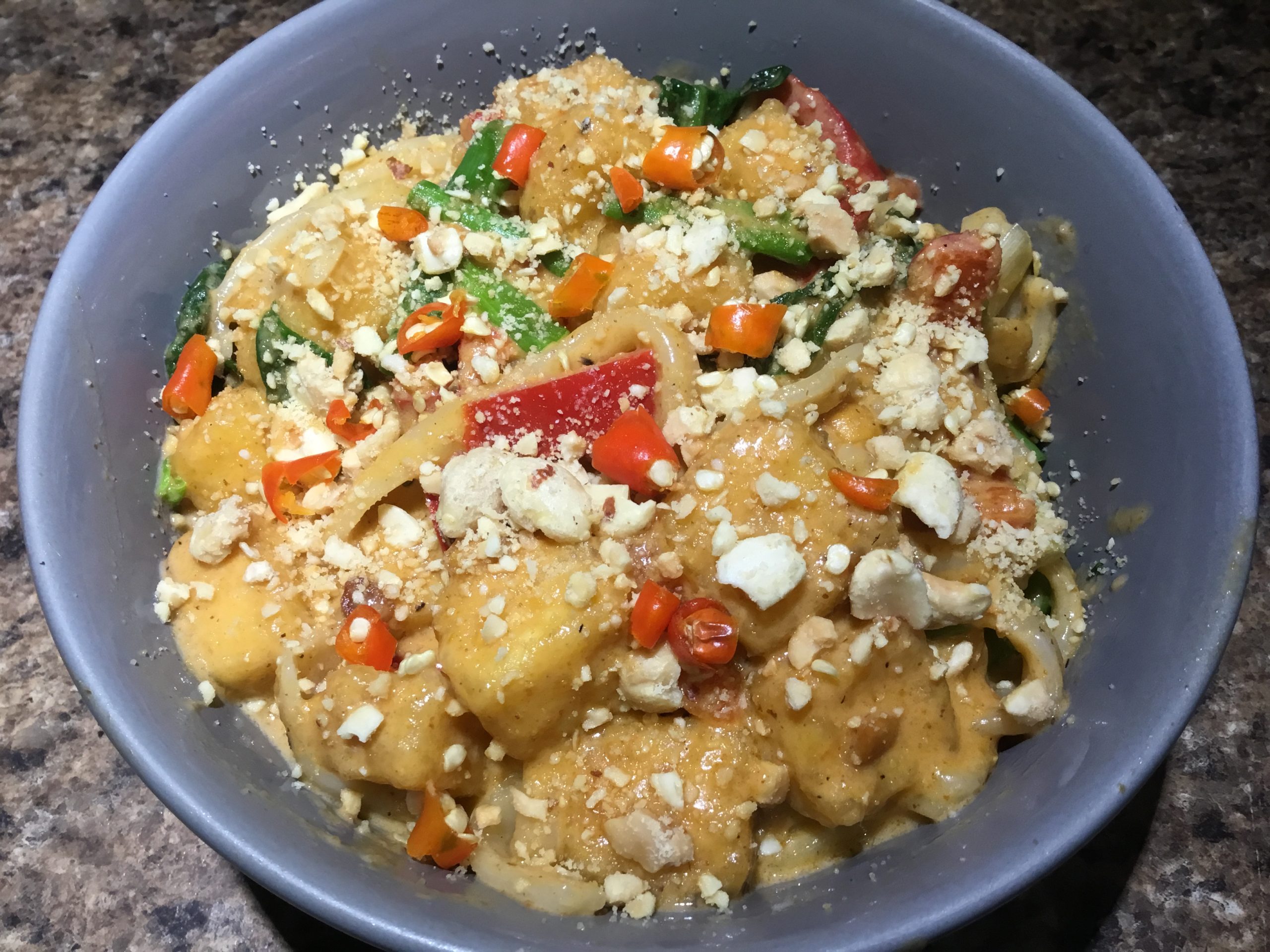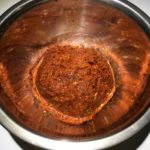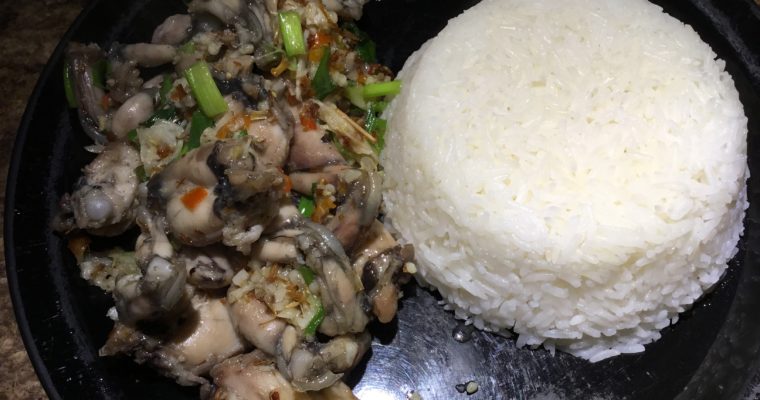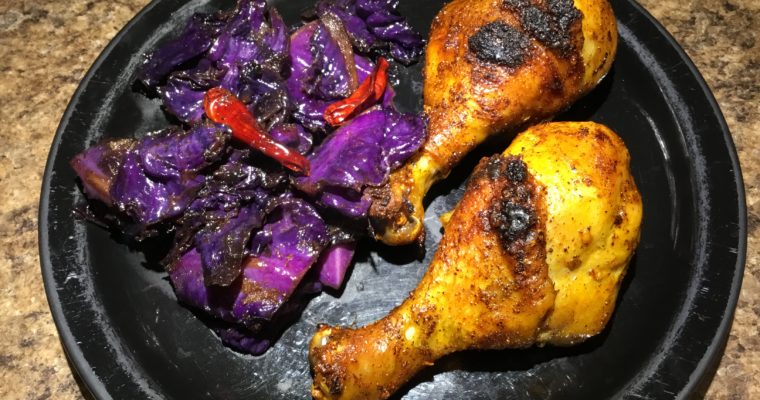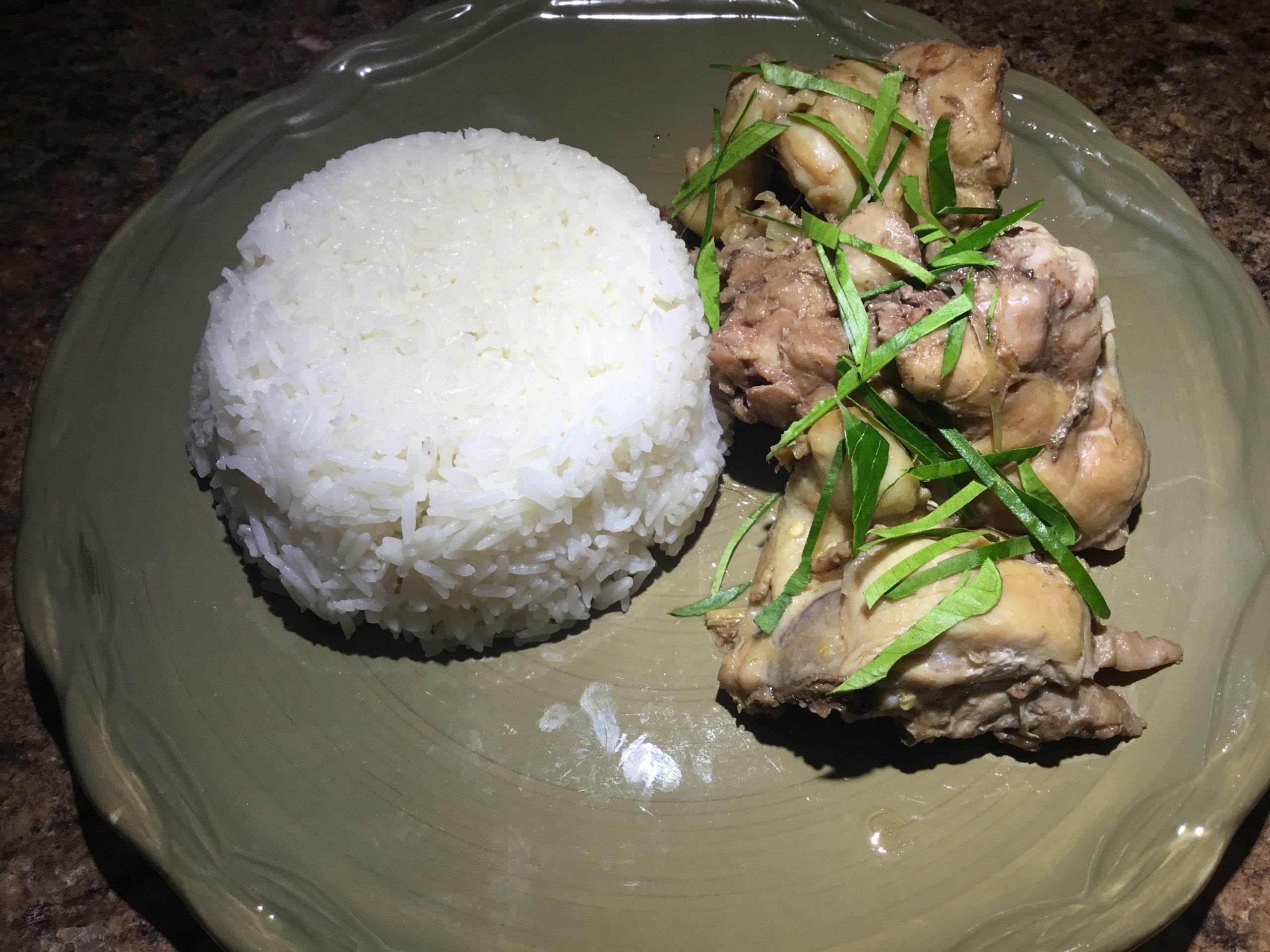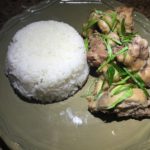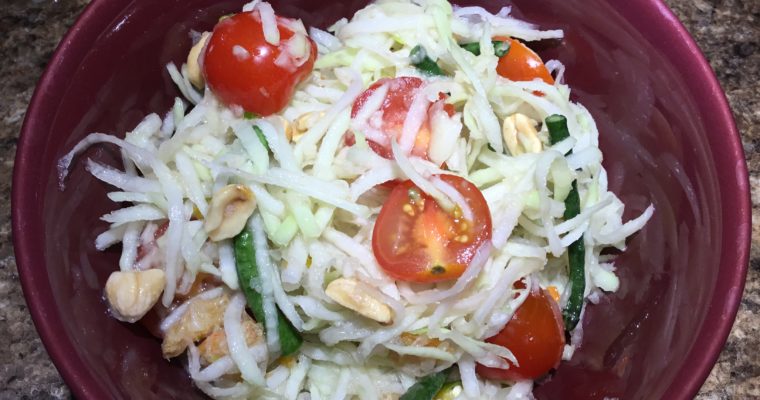Tag: southeast asian
Pork Giniling
Pork Giniling
Pork Giniling is an easy 1 pot meal that requires minimum prep work; pretty much cutting up onions, garlic, bell peppers, potatoes, and carrots. Giniling is a ground pork stew with a variety of vegetables in a sweet and spicy tomato sauce. The pork giniling also contains quail eggs and golden raisins. I must admit, I’m not a huge fan of raisins. Once eating this dish, I realized how much I like them in the giniling. They completely rehydrate from the sauce. They’re kind of like little balls of sweetness that pop when you eat them, adding another layer of texture. The quail eggs are my favorite part of the giniling. They add a nice creaminess to this dish and make me we to find more recipes to use them in.
Ingredients
- 1 tbsp vegetable oil
- 1 medium onion chopped
- 4 garlic cloves minced
- 1 small green bell pepper chopped
- 1 small red bell pepper chopped
- 1 lb ground pork
- 1 tbsp fish sauce
- 1 cup tomato sauce
- 1/4 cup banana ketchup
- 1 cup water
- 1 large potato cut into 1/2” cubes
- 2 small carrots sliced 1/2” thick
- 1 cup frozen peas thawed
- 1/2 cup golden raisins
- 1 can quail eggs drained
- salt and pepper to taste
Instructions
- Heat up cooking oil in a large sauce pan over medium high heat. Sauté the onions, garlic, red and green bell peppers for 5 minutes.

- Add in the ground pork. Cook for 8 minutes. Stir in the fish sauce, tomato sauce, banana ketchup, and water. Simmer for 5 minutes.

- Add in the potatoes and carrots. Cover and simmer for 15 minutes until the potatoes and carrots are cooked through.
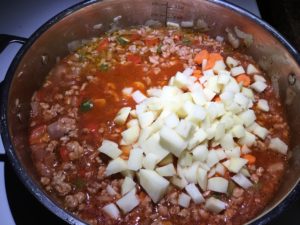
- Stir in the peas, golden raisins, and quail eggs. Simmer uncovered for 5 minutes. Season with salt and pepper to taste.
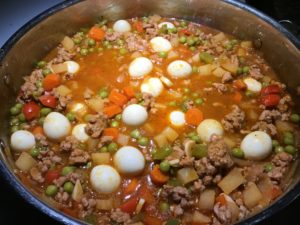
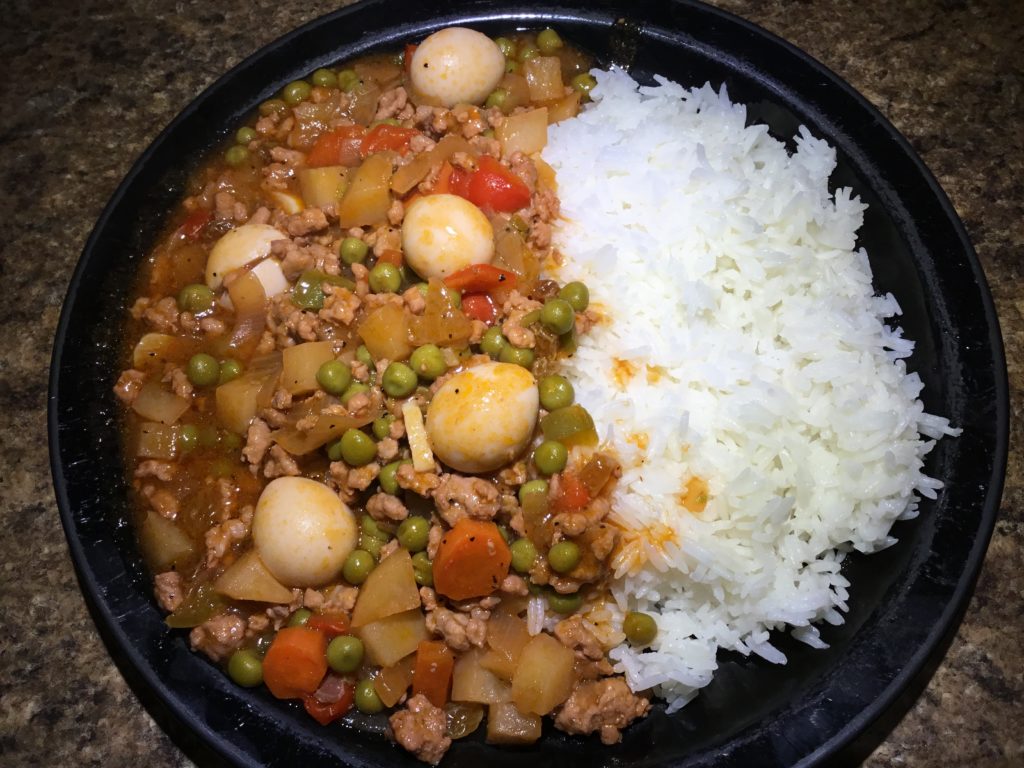
Coconut Peanut Noodles with Tofu
Coconut Peanut Noodles with Tofu
If you are good at multitasking, you can whip up this amazing coconut curry peanut noodles with tofu in under 30 minutes. This has a few steps in preparation, but is overall easy to make. Below, I will attach my recipes for homemade red curry paste(store bought will work well too) and fried tofu, since I will not review how to make these again in this recipe. While this dish is vegetarian, it is possible make it vegan. You will have to make your own red curry paste, omitting the shrimp paste. Then, leave out the fish sauce in the noodle recipe. If you want to un-vegan the noodles, pork, chicken, or shrimp are all great proteins to use. But honestly, the fried tofu in here is pretty damn good.
Ingredients
- 2 tbsp vegetable oil
- 2 tbsp red curry paste
- 2 cups coconut milk
- 1/2 cup peanut butter
- 2 tbsp fish sauce
- 3 tbsp palm sugar
- 1 red bell pepper sliced
- 1 cup fresh spinach washed
- 1/4 cup pasta water
- 3 portions kalguksa noodles or 14 oz cooked rice noodles
- 14 oz fried tofu small cubes
- green onions chopped
Garnish
- Thai chilies finely chopped
- peanuts chopped
Instructions
- Heat up cooking oil in a large sauté pan over medium high heat. Stir fry the red curry paste for 30 seconds.

- Stir in the coconut milk, peanut butter, fish sauce, and palm sugar. Simmer for 5 minutes.
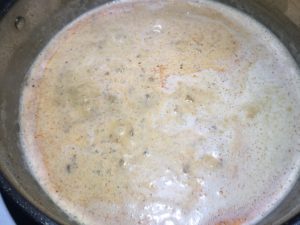
- Stir in red bell pepper and the saved pasta water. Simmer for 3-4 minutes.
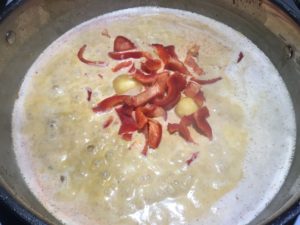
- Stir in the spinach, cooked noodles, and the fried tofu. Cook for 2 minutes.
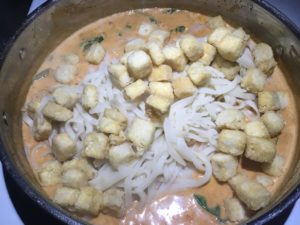
- Turn off the heat. Stir in the green onions.
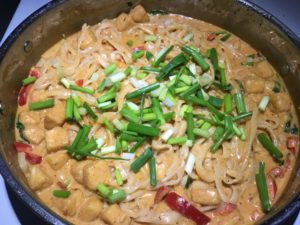
- Garnish with chopped peanuts and diced Thai chilies.
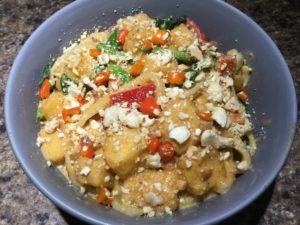
Red Curry Paste
I must admit that there are decent store bought curry pastes. But once you learn how to make your own, you’ll never go back. It will also cost you half the price.Let’s talk about some of the ingredients. All Thai curry pastes will have lemongrass, galangal, and lime zest or leaves. Then they will have some type of dried or fresh chili pepper with varying amounts of garlic, shallots, cilantro root, white peppercorns, coarse salt, and shrimp paste. This is pretty much the base for all curry pastes. Green curry paste will have these ingredients, but use fresh green Thai chilies, plus coriander, cumin, and fresh basil to get the green color. Panang curry paste add in coriander, cumin, and roast peanuts. Massaman curry paste adds in cumin, coriander, cardamom, cloves, cinnamon, and nutmeg.What makes red curry red is the use of dried red chilies. Guajillo chilies are a good base to start with the paste. They are fairly mild in heat. To add heat to the curry paste, I added 4 dried Thai chilies. I would give the heat level a 5/10 to the curry paste. Add another 4 to make it spicier. Once I had the chilies ground, I added all the other ingredients to my blender with a couple of tbsp of water. With a few pulses, scraping down the sides with a spatula, and a few more pulses, the paste was ready in about a minute.If you really want to make it traditionally, you will need to use a large mortar and pestle. Here is the specific order in which you will pound the ingredients into the paste: pound lemongrass, galangal, cilantro root, lime zest, white peppercorns, and salt until a fine paste; add in the ground chilies and mix; add in the garlic and shallots, pounding them into the paste until fine; add in the shrimp paste and pound into the rest of the ingredients. You may need to add a little bit of water if the paste is too dry. This takes a lot of work. A good 10 minutes of pounding as opposed to 1 minute of blending. If you want to be a purist about making the curry paste, go for it. Either way, you will get the same results.I like to make my curry pastes in large batches, freezing down what I won’t immediately use. This particular recipe will give you 2 recipes worth of my red curry with chicken recipe. The curry paste itself is good for 1 week in the refrigerator. Anything past that should be frozen.
Equipment
- Blender, food processor, or mortar and pestle
Ingredients
- 8 large dried guajilo chilies seeded
- 4 small dried Thai chilies seeded
- 1/4 tsp white peppercorns
- 1 tsp coarse salt
- 1/3 cup shallots
- 1 head garlic peeled
- 3 tbsp lemongrass
- 1 tbsp galangal chopped
- 1 tsp cilantro root
- 1 tsp lime zest or 4 lime leaves
- 1 tsp shrimp paste
Instructions
- Add the dried peppers, white peppercorns, and salt to a spice grinder. Grind until fine. Fine grinding.
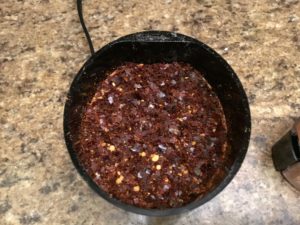
- Add all of the ingredients to a food processor or blender.
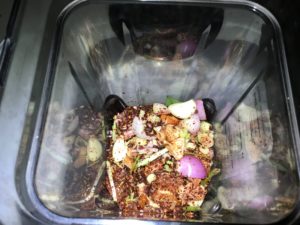
- Blend or process until it becomes a paste. You will probably need to add a little bit of water at a time if it becomes too dry. Carefully add a tbsp at a time. Scrap down the sides of the blender or food processor with a rubber spatula to make sure that all the ingredients have been incorporated with one another.
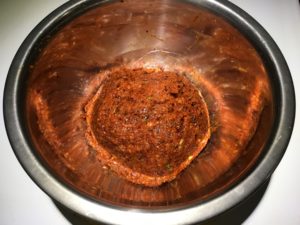
Fried Tofu
This is new territory for me. For my entire life, especially being a butcher, I’ve talked mad shit about tofu. MAD SHIT. How wrong I’ve been. If you are as closed minded about tofu as I used to be, I recommend trying it fried like this first. It is a great gateway into eating tofu. I had recently had it in a bowl of Kuay Jub at my favorite Thai restaurant, On’s Kitchen. And then something clicked in my head and stomach with it. I kinda can’t stop eating it. Maybe because I’m stoned as fuck. The first thing you want to look for when frying tofu is that it has to be firm tofu. Anything less than firm tofu has too much moisture and won’t hold it’s shape very well. The beauty of tofu is that it is $.99 a brick at my local Asian market. It also takes on pretty much whatever flavor you give it. It is great in stir fry, soups, or just on it’s own like how I prepared it.
Servings: 1
Ingredients
- 1 brick firm tofu
- 1/4 cup vegetable or canola oil
- salt
Garnishes
- siracha
- green onion
- toasted sesame seeds
- fried garlic
Instructions
- For frying tofu, make sure to use firm tofu.
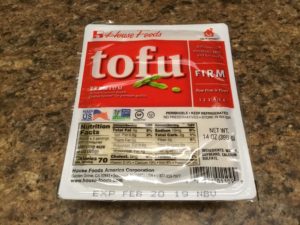
- Wrap tofu in a couple layers of paper towel.
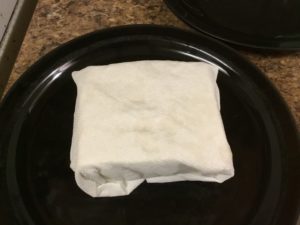
- Weigh down the tofu with another plate and something that weights around 3lbs. Let it be for 20 minutes. It is important when frying tofu to get out as much moisture as possible so the oil doesn’t spatter. Also, if there is any moisture left on the outside of the tofu, they will slightly stick to the bottom of the pan.
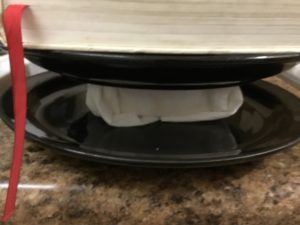
- Cut brick into 12 pieces. If you want them to be smaller, cut them smaller. Unless you plan on deep frying the tofu, I wouldn’t cut them any larger. Pat these down with more paper towel.
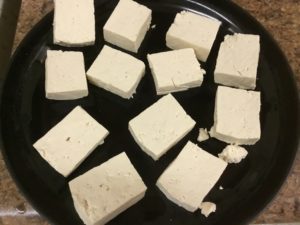
- Add cooking oil to a skillet on medium high heat. Since I’m using a smaller skillet, I cooked the tofu in 2 batches. Cook on the first side for 5 minutes.
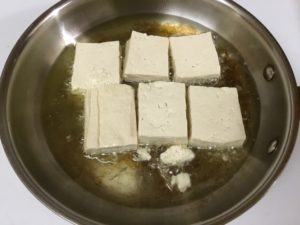
- Flip tp the other side and cook for another 5 minutes.

- Drain tofu on pare towel of excess grease. Salt.

- Throw the tofu in a bowl and toss with green onions, toasted sesame seed, siracha, and fried garlic.
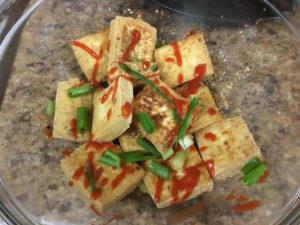
- Eat the fuck out of this.

Stir Fried Chili Lemongrass Frogs
Eat as an appetizer or serve as a main course with steamed rice.
Underwater Chicken
Underwater Chicken
You won’t find underwater chicken on a Thai menu. This dish is typically found in the rural countryside. Some real Thai home cookin. The chicken is marinated in soy sauce, fish sauce, and sugar; with the addition of lemongrass, garlic, shallots, and chilies that are individually pounded in a mortar with a pestle. So why is it called underwater chicken? Once the pot you’re cooking the chicken in is hot, add the chicken in with all of the marinade ingredients. Then, place a large enough metal bowl filled with cold water over the pot of chicken. The water needs to be changed out every 20 minutes with more cold water. The water should be scooped out instead of taking the bowl off of the pot. You want to keep the steam in. Once finished, scoop out the chicken with a slotted spoon. Strain the stock of the marinade ingredients and eat with the chicken and steamed rice.Lets talk about the science of what’s happening. The purpose of having a bowl of cold water over the pot of chicken is to create low pressure, the exact opposite of a pressure cooker. The chicken and the marinade are added to a dry pot. As the meat is cooking, it releases it’s natural juices. This why you have to use bone in chicken instead of boneless. Boneless = lack of juices. The juices turn into steam. Instead of covering the pot with a lid allowing the steam to release, the bowl of cold water holds in the steam juices, turning into liquid and dripping back down into the chicken. The steam will only condense if the bowl of water is cold. If the water gets hot, the steam will be escape and there will be no juice condensation. This whole process keeps the pot from burning and creates enough juice to braise in. Science.
Ingredients
- 4 bone in chicken thighs skinned, cut into 3-4 pieces
- 2 tbsp soy sauce
- 2 tbsp fish sauce
- 2 tsp sugar
- 1 stalk lemongrass pounded in a mortar
- 6 slices galangal pounded in a mortar
- 6 garlic cloves pounded in a mortar
- 1 large shallot pounded in a mortar
- 2 Thai chilies pounded in a mortar
- 6 lime leaves torn
Garnish
- lime leaves julienned
Instructions
- Skin your chicken thighs and cut into 3-4 pieces with a clever. Marinate the chicken with the rest of the ingredients for 30 minutes.
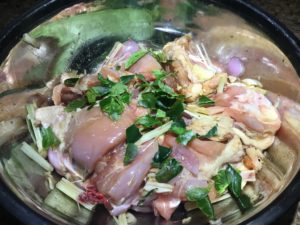
- Heat up a pot over medium heat. Pour in the chicken and all of the marinade.
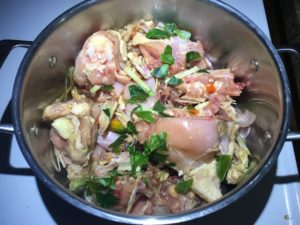
- Place a bowl of cold water on top of the pot. Change out the water every 20 minutes with more cold water. Scoop it out with a bowl instead of lifting it off of the pot. You want to keep the steam in.
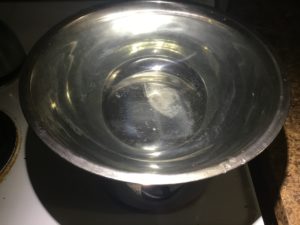
- At 60 minutes, take off the bowl of water.
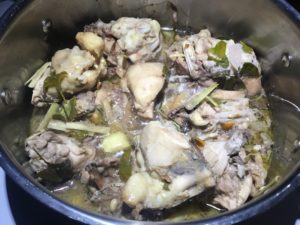
- Scoop out the chicken with a slotted spoon. Serve with steamed rice. Garnish with julienned lime leaves.
